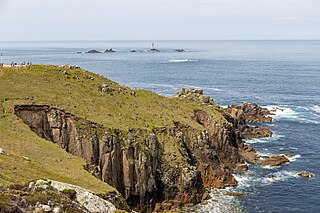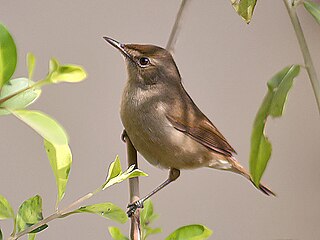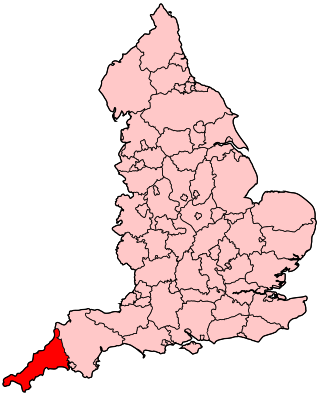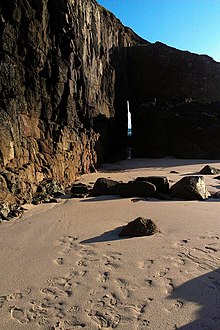
Land's End is a headland and tourist and holiday complex in western Cornwall, England, United Kingdom, on the Penwith peninsula about eight miles (13 km) west-south-west of Penzance at the western end of the A30 road. To the east of it is the English Channel, and to the west the Celtic Sea.

The cuckoo, common cuckoo, European cuckoo or Eurasian cuckoo is a member of the cuckoo order of birds, Cuculiformes, which includes the roadrunners, the anis and the coucals.

The Acrocephalus warblers are small, insectivorous passerine birds belonging to the genus Acrocephalus. Formerly in the paraphyletic Old World warbler assemblage, they are now separated as the namesake of the marsh and tree warbler family Acrocephalidae. They are sometimes called marsh warblers or reed warblers, but this invites confusion with marsh warbler and reed warbler.

Blyth's reed warbler is a species of reed warbler belonging to the family Acrocephalidae, which also includes the tree warblers. Blyth's reed warbler breeds across the Palearctic zoogeographical region and winters in South Asia. The species has been expanding its range westwards in Europe.

Aire Point to Carrick Du SSSI is a Site of Special Scientific Interest on the Penwith Peninsula, Cornwall, England. It is 5.98 square kilometres in extent, stretching from grid reference SW360279 to grid reference SW513410. The site is designated both for its biological and its geological interest.

St Levan is a civil parish in Cornwall, England, United Kingdom. The parish is rural with a number of hamlets of varying size with Porthcurno probably being the best known. Hewn out of the cliff at Minack Point and overlooking the sea to the Logan Rock is the open-air Minack Theatre, the inspiration of Rowena Cade in the early 1930s.

Portloe is a small village in Cornwall, England, on the Roseland Peninsula, in the civil parish of Veryan. Portloe harbours two full-time working fishing vessels, the Jasmine and Katy Lil, which fish for crab and lobster in Veryan and Gerrans Bay, and a fleet of smaller leisure boats in summer. Visitors are attracted to Portloe by its fishing, scenery, and walks.

Porthgwarra is a small coastal village in the civil parish of St Levan, Cornwall, England, United Kingdom situated between Land's End and Porthcurno. Access to the cove is via a minor road off the B3283 road at Polgigga and leads to the car park in the village. Public conveniences include a pay telephone, a small shop and café. The South West Coast Path passes through Porthgwarra, approximately 90 minutes walk from Land's End and 45 minutes from Porthcurno.

Gwennap Head is a headland on the south coast of the Penwith peninsula, Cornwall, United Kingdom. It is within the parish of St Levan and approximately 4 miles (6.4 km) south of Land's End, and less than 1 mile (1.6 km) north-west of Porthgwarra, the nearest village. The area of Gwennap Head is designated as part of the Penwith Heritage Coast and also designated as part of the Cornwall Area of Outstanding Natural Beauty. The South West Coast Path closely follows the coastline around the headland.

The large-billed reed warbler is an Old World warbler in the genus Acrocephalus. The species has been dubbed as "the world's least known bird". It was known from a single specimen collected in India in 1867 and rediscovered in the wild in Thailand in 2006. The identity of the bird caught in Thailand was established by matching DNA sequences extracted from feathers; the bird was released. After the rediscovery in the wild a second specimen was discovered amid Acrocephalus dumetorum specimens in the collections of the Natural History Museum at Tring. A breeding area was found in Afghanistan in 2009 and studies in 2011 pointed to its breeding in Kazakhstan and Tajikistan. One bird was found in the Baikka Wetland in Srimangal, Bangladesh on 7 December 2011.

Mawgan Porth is a beach and small settlement in north Cornwall, England. It is north of Watergate Bay, approximately four miles (6 km) north of Newquay, on the Atlantic Ocean coast.

Treen Cliff is a Site of Special Scientific Interest (SSSI) located on the Penwith Peninsula in Cornwall, England, UK, 6 miles (9.7 km) south-west of Penzance. First notified in 1951, with a revision in 1973, and a further notification on 1 July 1986, it is 49.3 hectares in area, stretching from grid reference SW387220 to SW402225. Designated for both for its biological and geological interest, part of the site, Treryn Dinas, is a Scheduled Ancient Monument consisting of a "cliff castle" with four ramparts and ditches and the Logan Rock. It is within the Cornwall Area of Outstanding Natural Beauty (AONB), the Penwith Heritage Coast and is part owned and managed by the National Trust.

Portholland is a settlement in Cornwall, England, UK. It is on the south coast in the civil parish of St Michael Caerhays. The name Portholland comes from the Cornish language elements porth, meaning 'cove' or 'harbour', and Alan, a personal name.

Porth Hellick is a tidal inlet on the south coast of St Mary’s, the largest island in the Isles of Scilly.

Cornish promontory forts, commonly known in Cornwall as cliff castles, are coastal equivalents of the hill forts and Cornish "rounds" found on Cornish hilltops and slopes. Similar coastal forts are found on the north–west European seaboard, in Normandy, Brittany and around the coastlines of the British Isles, especially in Wales, Scotland and Ireland. Many are known in southwest England, particularly in Cornwall and its neighbouring county, Devon. Two have been identified immediately west of Cornwall, in the Isles of Scilly.

The following outline is provided as an overview of and topical guide to Cornwall: Cornwall – ceremonial county and unitary authority area of England within the United Kingdom. Cornwall is a peninsula bordered to the north and west by the Celtic Sea, to the south by the English Channel, and to the east by the county of Devon, over the River Tamar. Cornwall is also a royal duchy of the United Kingdom. It has an estimated population of half a million and it has its own distinctive history and culture.
Presented below is an alphabetical index of articles related to Cornwall:

St Buryan was an electoral division of Cornwall in the United Kingdom which returned one member to sit on Cornwall Council between 2009 and 2021. It was abolished at the 2021 local elections, being succeeded by Land's End, Ludgvan, Madron, Gulval and Heamoor, and Mousehole, Newlyn and St Buryan.
























